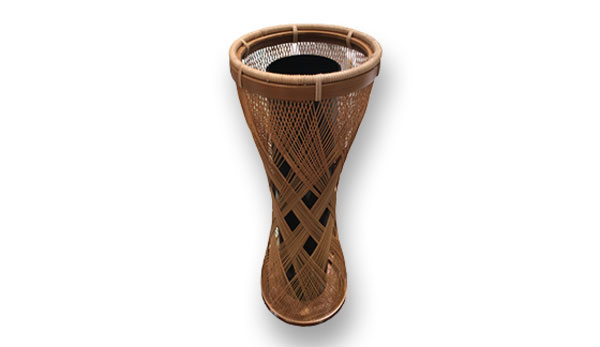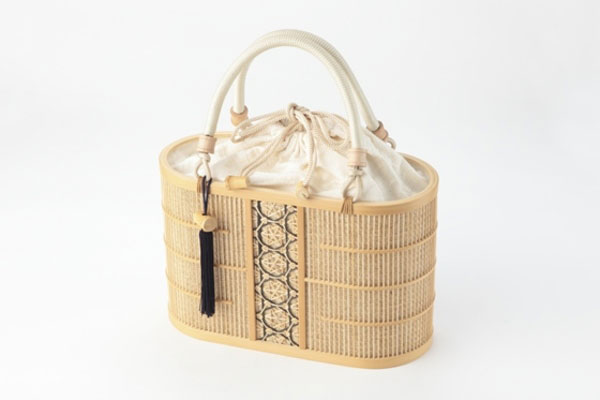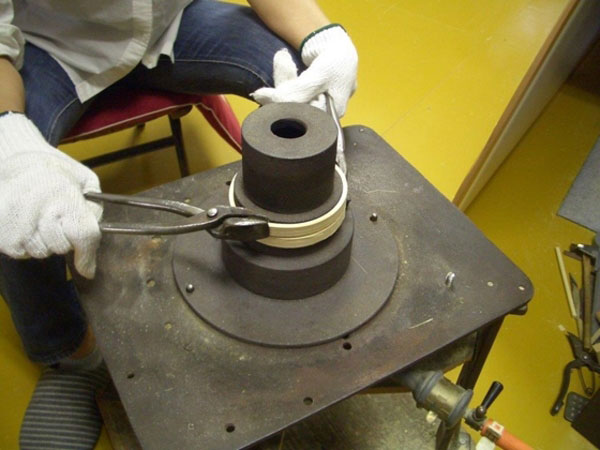
- Wood, bamboo crafts
- Shizuoka
Suruga bamboo crafts Suruga takesensuji zaiku
A woven mesh of light and round bamboo strips
Graceful, harmonious curves
Description
What is Suruga bamboo crafts ?
Suruga bamboo ware (called Suruga take sensuji zaiku in Japanese) is produced in the city of Shizuoka, Shizuoka prefecture. High quality bamboo has grown wild in the basin of the upper reaches of the Abe River in Shizuoka since ancient times. Bamboo ware has been made in this region for thousands of years.
This craft is notable for being woven out of thin bamboo strips measuring as little as 0.8 mm in diameter. The name sensuji (meaning one thousand lines) refers to the fact that a thousand fine bamboo strips can be laid out on a 90 cm (about 35.4 inches) wide tatami mat. There are several bamboo ware production regions across Japan such as Kyushu or Hokuriku. However, most of them use flat strips for weaving, while this craft uses extremely fine round strips. A bamboo piece is made by using a unique bending technique to create thin flexible strips, which are inserted into a bamboo base frame drilled with small holes and then woven into beautiful free-form shapes. Nearly the entire production process, from cutting the strips to the assembly, is done by a single craftsman.
The finished bamboo ware perfectly showcases the color, luster, and texture of bamboo. The elegance of the round strips is visually appealing.
History

The basin of the Abe River and the neighboring Warashina River has been a production center of fine quality bamboo since ancient times. Bamboo baskets and perforated strainers have been excavated from Toro archaeological site in Shizuoka, lending credence to the idea that bamboo ware was in daily use during the latter stage of the Yayoi period (300 BC-250 AD).
In 1607, when Tokugawa Ieyasu* chose Sunpu Castle in Suruga province (Shizuoka) as his residence, many different kinds of artisans moved to Suruga and developed it as a production center of various crafts. As a result, the name Suruga bamboo ware became widely used. During the early years of the Edo period (1603-1868), woven bamboo pillows became popular among daimyo (feudal lords), who stopped by rest stations during their alternate-year of residence in Edo (ancient name of Tokyo). According to old written records, the region was producing woven bamboo hats, instead of the expensive rattan braided hats widely favored in Edo between the years 1624-1644. Bell cricket cages and baskets for storing bait for falconry were also produced.
Suruga bamboo ware started being made with round strips in 1840 when Ichiga SUGANUMA, a servant of the Okazaki domain, visited Suruga and taught his techniques to Inobei SHIMIZU, a son of an inn keeper. Over the years, Shimizu kept developing the techniques, finally producing the delicate craft seen today.
*(1543-1616), founder of the Tokugawa shogunate which was the last feudal military government.
General Production Process

- 1. Measuring and cutting bamboo
The main bamboo types that are used are madake, hachiku, mosochiku, or kurochiku. It is measured using a ruler, cut with a saw, boiled in hot water to remove the oil content, and then left to dry in the sun.
- 2. Splitting the bamboo
To remove scratches and dirt from the surface, the outer layer is shaved, and the bamboo is cut to about a centimeter in width. Since bamboo has strong vertical fibers, it is easily split with a hatchet. Strips are shaved and thinned by hatchet. Round strips are made from bamboo just below the outer layer.
- 3. Deciding the thickness
The thickness of the strips are determined and cut with a sendai (mechanized shears).
- 4. Making the base ring
A metal cylinder is heated over a gas stove and a bamboo strip is wound around it to make a ring. After holding the bamboo around the cylinder for about twenty seconds, it is cooled and shaped within a frame to create a beautiful ring. The ends of the bamboo ring are cut diagonally and joined with a special glue. A distinctive joinery technique called tsugite is used to make the joint virtually invisible.
- 5. Cutting strips
A small knife is used to make a fine incision in the bamboo, which is then further split by hand. The tip is thinly shaved and tapered to a point.
- 6. Rounding strips
The bamboo strips are rounded by being pulled through a series of diminishing holes in an iron plate. The holes make the bamboo go from a coarse finish to medium finish to a smooth, finished round strip.
- 7. Bending
The bamboo strips can be woven to produce straight-lined items such as cricket cages, but also by carefully bending them, it is possible to make bamboo ware in a variety of shapes such as flower vases or lamp shades. Twenty to thirty bamboo strips are laid upon an electric-heated curved iron plate and bent at the same time. Uneven bending will affect the finished work, so the task requires much skill and care. Curved irons vary in size from two to fifteen centimeters in diameter and are used to bend the strips along the curves of the design.
- 8. Drilling
The bamboo ring is marked and holes are individually machine-drilled. Slightly changing the angle of the hole will create a different effect when the weaving is complete.
- 9. Assembly
Round strips are inserted in the ring holes and the piece slowly takes form with careful bending and manipulation. Suruga bamboo ware is renowned for its elegant curves and shapes.
Where to Buy & More Information
Sunpu Takumi Yado
-
Address
-
Tel.+81-54-256-1521
-
ClosedMondays
-
Business Hours10am to 7pm
-
Website
See more Wood, bamboo crafts
- Hakone wood mosaic
- Iwayado traditional chest
- Kaba cherrybark woodcrafts
- Odate bentwood
- Inami wood carvings
- Matsumoto furniture
- Beppu bamboo crafts
- Edo wood joinery
- Ichii woodcarvings
- Suruga bamboo crafts
- Edo bamboo fishing rods
- Kishu bamboo fishing rods
- Kamo traditional chest
- Kyo wood joinery
- Miyakonojo archery bows
- Osaka carved wooden panel
- Miyajima woodwork
- Nibutani carved wooden tray
- Okuaizu Basketry
- Echizen traditional chest
- Kasukabe traditional paulownia chest
- Katsuyama bamboo crafts
- Osaka karaki wood joinery
- Takayama tea whisks
- Toyooka wicker crafts
- Akita cedar tubs and barrels
- Nagiso woodturning
- Kishu traditional chest
- Nagoya traditional paulownia chest
- Osaka bamboo screens
- Osaka-senshu traditional paulownia chest
- Sendai traditional chest































































































































































































































































































